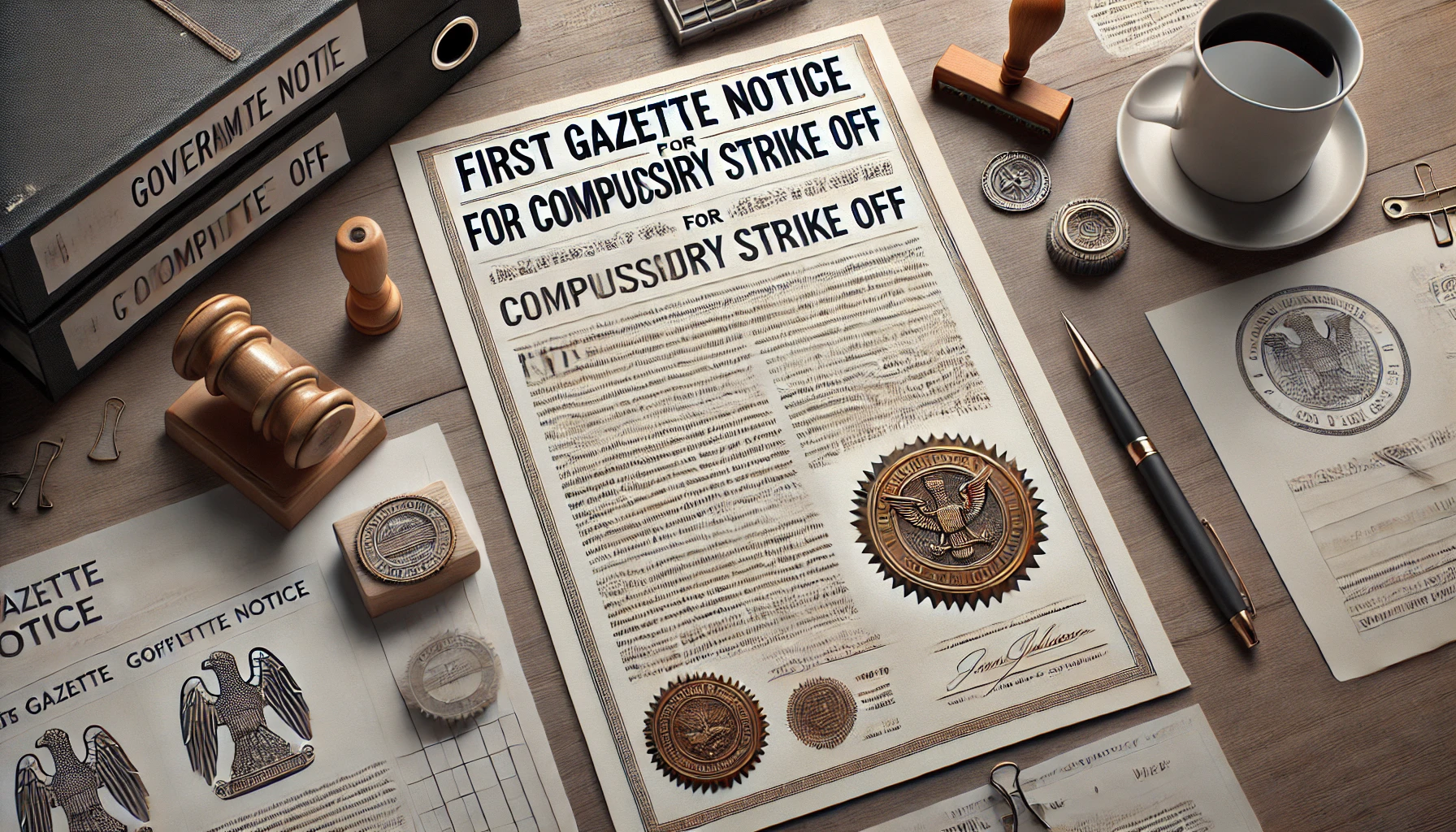The First Gazette Notice for Compulsory Strike-Off is a crucial document that every company director should understand.
Issued by Companies House in the UK, this notice signifies that a company is at risk of being removed from the Companies Register.
The process can seem daunting, especially for business owners who may not be aware of their obligations or the implications of receiving such a notice.
Ignoring it can lead to serious consequences, including the dissolution of the company and legal implications for its directors.
This article will explore the reasons behind the issuance of a first gazette notice for compulsory strike off, its implications, and the steps you can take to address or avoid it.
What Is a First Gazette Notice for Compulsory Strike-Off?

A First Gazette Notice for Compulsory Strike-Off is an official announcement by Companies House. It indicates that a company is at risk of being struck off the Companies Register and dissolved. This notice is published in The Gazette, an official public record in the UK.
The notice typically arises due to non-compliance with statutory requirements, such as failing to file annual accounts or confirmation statements.
Once issued, it serves as a warning that unless action is taken, the company will cease to exist as a legal entity.
Key aspects of a First Gazette Notice:
- It marks the start of the compulsory strike-off process.
- Creditors, directors, and stakeholders are informed of the impending action.
- Once a company is struck off, its assets become Crown property unless restored.
Understanding this notice is the first step in preventing irreversible consequences for your business.
Why Would a Company Get a First Gazette Notice?
A First Gazette Notice for Compulsory Strike-Off is issued by Companies House when a company fails to meet its statutory obligations or appears to be no longer operational.
This process acts as a formal warning that the company is at risk of being struck off the Companies Register. If directors do not respond to initial correspondence, Companies House assumes the business has ceased operations.
Acting promptly upon receiving this notice is crucial, as it may be resolved by updating overdue filings and rectifying any non-compliance.
Common Reasons a Company Receives This Notice:
- Failure to File Accounts: Not submitting annual accounts or confirmation statements within the required timeframe.
- Dormancy: If a company has been dormant or inactive for an extended period.
- Voluntary Dissolution Requests: When directors mistakenly or intentionally apply for the company’s closure.
- Inaccurate Records: Neglecting to maintain up-to-date company details with Companies House.
Consistently meeting filing deadlines and adhering to the Companies Act regulations can help prevent such notices and maintain good standing.
What Are the Consequences of a Strike-Off?

The consequences of a compulsory strike-off can be significant for companies and their directors, impacting both their operations and personal liabilities.
Loss of Legal Status
- When a company is struck off, it ceases to exist as a legal entity. This means it can no longer engage in business activities, enter into contracts, or own property.
Asset Seizure
- Any assets belonging to the company automatically become the property of the Crown under the doctrine of “bona vacantia.”
Impact on Directors
- Directors may face penalties, including fines or disqualification, especially if the non-compliance leading to the strike-off was intentional or negligent.
Creditor Implications
- Unpaid debts remain enforceable. Creditors may take legal action against the directors personally, particularly if company resources are mismanaged.
While the strike-off process is severe, it is not entirely irreversible. Specific legal steps, such as filing overdue documents or applying for company restoration, can address the situation.
However, these processes can be time-consuming and costly, highlighting the importance of proactive compliance to avoid these consequences altogether.
How Does the Compulsory Strike-Off Process Begin?
The compulsory strike-off process begins when Companies House identifies that a company has failed to meet its statutory obligations or appears inactive. Steps Involved:
Initial Reminder
Companies House sends reminders to directors about overdue filings, such as annual accounts or confirmation statements.
Notice Issued
If the company does not respond to the reminders, the First Gazette Notice is issued. This serves as an official warning of the impending strike-off.
Public Record
The notice is published in The Gazette, making it a matter of public record. This alerts creditors and stakeholders about the potential dissolution.
Timeline for Action
Directors are typically given two months to address the non-compliance by submitting the necessary filings or providing evidence of activity.
Failure to act within the specified timeframe will lead to the next stage of the process, which could result in the company being dissolved. Being proactive and addressing the issues early can prevent escalation.
What Happens After a First Gazette Notice Is Issued?

When a First Gazette Notice is issued, it serves as an official warning that a company is at risk of being struck off.
This notice triggers a series of steps that require immediate attention from the company directors.
Immediate Steps for Directors:
- Identify the Issue: Review the reason for the notice. Typically, it involves overdue accounts or confirmation statements.
- Take Action: Gather and submit the required documents to Companies House to rectify the situation.
- Notify Stakeholders: Inform creditors, employees, and shareholders about the notice to manage expectations and avoid confusion.
If the company does not act, a second Gazette Notice may follow, which indicates that the company is closer to being dissolved.
Once dissolution occurs, the company is removed from the register, and its assets are transferred to the Crown.
Acting promptly after the issuance of the first notice can save the company from severe legal and financial consequences.
How Can You Stop a First Gazette Notice for Compulsory Strike-Off?
Stopping a First Gazette Notice requires quick and decisive action to address the underlying issues. Companies House allows businesses to rectify non-compliance, provided they act within the specified timeframe.
Steps to Halt the Process:
Submit Overdue Documents
- File the missing accounts or confirmation statements immediately. Delays can make the process more complicated.
Contact Companies House
- Reach out directly to Companies House, explain the situation, and seek advice on the best course of action to prevent further escalation.
Provide Evidence of Activity
- If the company was inactive or dormant, show proof of recent business activity, such as invoices or contracts.
Taking these actions promptly can stop the notice and restore the company to good standing. It is vital to act within the two-month period provided after the notice is published in The Gazette.
Is a First Gazette Notice Bad for Your Business?

Receiving a First Gazette Notice is a significant warning for your business. While it may not immediately impact operations, ignoring the notice can have severe repercussions.
Negative Consequences:
- Permanent Dissolution: The company will be struck off the register and cease to exist.
- Reputational Damage: Stakeholders, including clients and investors, may lose confidence in the business.
- Legal Issues: Directors could face fines, disqualification, or personal liability for unpaid debts.
Addressing the notice quickly allows the company to rectify its status and avoid these outcomes.
Although the notice is severe, it is also an opportunity to resolve compliance issues and demonstrate accountability as a director.
What Is a Second Gazette Notice for Compulsory Strike-Off?
If the issues raised in the First Gazette Notice are not addressed, a Second Gazette Notice is issued. This notice is the final step before the company is dissolved and removed from the Companies Register.
Key Points:
- Final Warning: The second notice acts as a declaration that the company will be struck off imminently unless corrective action is taken.
- Limited Time: The company has only a short window to respond and prevent dissolution at this stage.
- Public Record: The notice is published in The Gazette, providing transparency and alerting creditors to take action if needed.
Once the second notice is published, dissolution becomes almost inevitable unless the directors take immediate steps to file overdue documents or challenge the process.
Understanding the transition from the first to the second notice is essential for businesses aiming to protect their status.
How Long Does the First Gazette Notice Process Take?

The process following a First Gazette Notice can vary depending on the company’s response. Initially, Companies House publishes the notice in The Gazette, granting a two-month period for the company to resolve the issues.
During this time, creditors, directors, and stakeholders have the opportunity to appeal or provide evidence that the company should remain on the register.
If no objections are raised or actions are taken, Companies House proceeds to the next stage by issuing a Second Gazette Notice, signalling the imminent strike-off. After this, the company is formally dissolved, and its legal status ceases.
Key Stages in the Timeline:
- Initial Notice: Published with a two-month window for corrective action.
- Second Notice: Issued if unresolved, marking the final warning before dissolution.
- Dissolution: This occurs if no objections or compliance steps are undertaken within the timeframe.
Time is of the essence. Prompt responses and thorough documentation are vital to halting the strike-off process and maintaining your company’s standing.
Can a First Gazette Notice Be Removed?
Yes, a First Gazette Notice can be removed by addressing the underlying issues that prompted its issuance.
Companies House allows directors to rectify non-compliance and provide evidence of compliance to avoid further action.
Steps to Remove a First Gazette Notice:
- File Overdue Documents: Submit annual accounts, confirmation statements, or any required statutory filings.
- Pay Fines and Fees: Settle any penalties associated with late submissions or non-compliance.
- Contact Companies House: Provide evidence that all obligations have been met and request withdrawal of the notice.
Once the issues are resolved, Companies House updates the company’s status, retracts the notice, and cancels the strike-off process. Swift action and communication can ensure your company remains on the register.
What Are the Responsibilities of Directors When Facing a Strike-Off?

Directors are legally obligated to safeguard the company’s interests, even when facing a strike-off notice.
Failing to act responsibly can result in personal liabilities, legal consequences, and damage to their professional reputation.
Directors’ Key Responsibilities:
- Ensure Compliance: Submit overdue accounts, confirmation statements, and any required documentation.
- Inform Stakeholders: Notify creditors, employees, and shareholders about the strike-off notice and its potential implications.
- Take Corrective Action: Act promptly to address non-compliance and restore the company’s good standing.
Directors who neglect their duties risk penalties, including disqualification from managing other companies. Maintaining precise records and staying proactive in meeting obligations is essential.
What Happens If a Company Is Dissolved by Strike-Off?
When a company is dissolved through the strike-off process, it loses its legal standing and is removed from the Companies Register.
This means the business ceases to exist as a separate entity and can no longer operate.
Key Consequences of Dissolution:
- Loss of Legal Status: The company cannot trade, hold contracts, or operate bank accounts.
- Transfer of Assets: Any remaining assets become the property of the Crown, a process known as bona vacantia.
- Director and Creditor Implications: Creditors can pursue unpaid debts, and directors may face legal action if they fail to comply with their responsibilities.
Although dissolution is final, the company can be restored through legal means, but this is a complex and costly process.
How to Prevent Strike-Off?

Preventing a strike-off is far simpler and less stressful than attempting to reverse it after the fact. By maintaining compliance with Companies House requirements, directors can ensure their company remains in good standing.
Key Prevention Measures:
- Timely Filings: Submit annual accounts and confirmation statements before deadlines.
- Accurate Record-Keeping: Maintain updated company information, including changes in directors or business activities.
- Responsive Communication: Address notices or correspondence from Companies House promptly to avoid escalation.
By staying vigilant and proactive, directors can mitigate the risk of strike-offs and safeguard their business’s future.
Conclusion
The First Gazette Notice for Compulsory Strike-Off is a serious warning requiring immediate action. It’s vital for business owners to understand the process, its implications, and how to address or prevent it.
This notice signals that your company may be removed from the register, which can lead to significant financial and legal consequences.
Staying proactive and compliant with filing obligations is key to avoiding this outcome. Addressing the notice promptly, seeking professional advice if needed, and taking corrective steps can help safeguard your company’s future.
By staying vigilant, you can avoid the costly repercussions of a strike-off and ensure your business remains operational.
FAQs About First Gazette Notice for Compulsory Strike-Off
What is the difference between a voluntary and compulsory strike-off?
A voluntary strike-off is initiated by the company directors when the company is no longer needed, while a compulsory strike-off is enforced by the Companies House due to non-compliance or inactivity. The key difference lies in the reason and the party initiating the process.
Can a company continue trading after a first Gazette notice?
Technically, a company can continue trading after a first Gazette notice, but doing so is risky and not advisable. Directors should focus on resolving the issue to avoid further legal complications.
How long does it take from the first Gazette to strike off?
The process typically takes two months from the date of the first Gazette notice, provided no action is taken to resolve the issue. If the company addresses the problem, the process may be halted.
Do I need to tell HMRC if I strike off a company?
Yes, you must inform HMRC about the strike-off and ensure all outstanding taxes and liabilities are settled. Failure to do so can result in penalties or legal action.
Are there penalties for ignoring a first Gazette notice?
Ignoring a first Gazette notice can lead to company dissolution, asset seizure, and personal liability for directors. Creditors may also pursue legal action for unpaid debts.
How does a dissolved company affect creditors and employees?
When a company is dissolved, creditors may lose their ability to recover debts, and employees lose their employment and associated benefits. Any remaining assets are transferred to the Crown unless restored.
What is the role of Companies House in the strike-off process?
Companies House monitors compliance and issues notices when companies fail to meet legal requirements. It oversees the strike-off process and updates the Companies Register accordingly.
How can directors ensure compliance to avoid a strike-off?
Directors can ensure compliance by filing annual accounts and confirmation statements on time and maintaining accurate company records. Regular communication with Companies House helps address any issues promptly.
Is it possible to restore a company after it has been struck off?
Yes, a company can be restored by court order or administrative restoration if certain conditions are met, such as settling outstanding filings. This process often involves legal fees and additional documentation.





